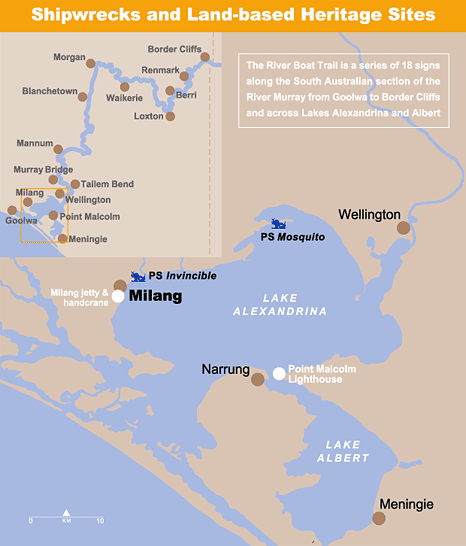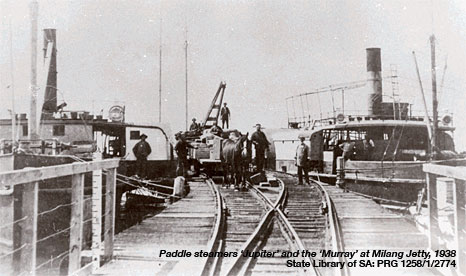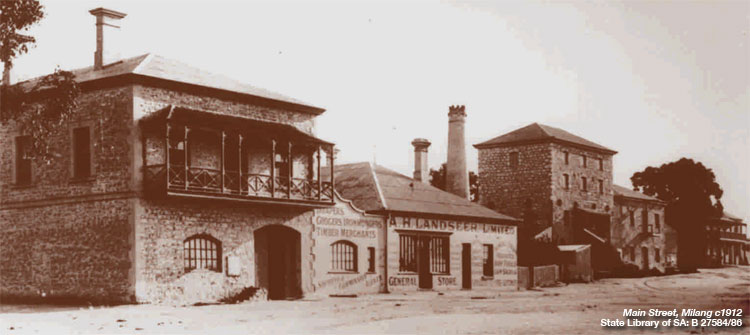
At its peak in the 1860s and 70s, Milang was a bustling port
 Milang
Milang
Landseer's Town
At its peak in the 1860s and 70s, Milang was a bustling port. It served the river trade passing to and from Goolwa and the fleet of small sailing schooners and steamers plying Lakes Alexandrina and Albert.
Prior to the building of rail links upstream, wool from the Darling and the upper Murray was unloaded at Milang and hauled overland to Port Adelaide.
By the 1860s Milang was a significant point on the main Adelaide to Melbourne road, which involved a lakes crossing between Milang and Meningie. Many of the river boats based in the port also aided the settlers on the shores of Lakes Alexandrina and Albert. Steamers carried passengers, mail and almost every type of cargo to stations such as Poltalloch and Campbell House, to the settlements at Port McLeay and Narrung and to many small landing places between Milang and Meningie.
Between 1857 and 1900, a number of paddle steamers, barges and sailing boats were built at a dry dock in the port. The PS Etona, a river mission steamer, was built here for the Church of England in 1898 and served the river communities until 1912.
Milang Jetty and Hand Crane
The Milang Jetty was built in 1856. Because of shallow water and increasing steamer traffic it was extended in 1860 and again in 1869, but was shorted in 1958.
The hand crane was placed here in 1872. It was believed to be the oldest crane of this type in South Australia and was probably made earlier and transferred to this site.
 The 'Milang Jetty and Hand Crane' is a significant State Heritage Place associated with the history of the River Murray trade. It is protected under the Heritage Places Act 1993.
The 'Milang Jetty and Hand Crane' is a significant State Heritage Place associated with the history of the River Murray trade. It is protected under the Heritage Places Act 1993.
Albert Henry Landseer
'Duke of Milang'
Albert Landseer was one of South Australia's principal river merchants. His company began in Milang in 1860, as a modest shipping agency that grew to become one of the largest trading, milling, and shipping concerns on the Murray with agents and branches in many river towns.
The ships controlled by A.H. Landseer & Co. initially engaged in local trade on the lower river and the lakes, carrying goods such as galvanised iron, timer and bricks.
As the business grew, services expanded to include other goods, passengers and mail and then extended further upsteam to include the wool and grain trades.
Landseer ambitiously commissioned and launched a floating dock at Milang in 1873. It was described at the time as the largest in the Southern Hemisphere.
Unfortunately the lake was too shallow for the dock to submerge and so it was sold to William Randell and relocated to Mannum.
A.H. Landseer & Co. also had large woolsheds at Goolwa and Port Victor (Victor Harbor) as well as flour mills at Milang and Morgan. The latter was completed in 1878 to coincide with the opening of the railway to Morgan.
Milang was often known as 'Landseer's Town', with Albert known as the 'Duke of Milang'.

GPS: Zone 54 E 0316141 N 6079853
Panel in the reserve overlooking the Milang Jetty
Interpretive panels are located at:
River Boat Trail | Border Cliffs | Renmark | Berri | Loxton | Waikerie | Morgan | Blanchetown | Mannum
Murray Bridge | Tailem Bend | Wellington | Meningie | Point Malcolm | Milang | Goolwa
Please do not interfere in any way with ship-wrecks and land based heritage sites
Published with permission of Government of South Australia
Department for Environment and Heritage
Tell your friends you found this at murrayriver.com.au!
Copyright Discover Murray 2026. This site or any portion of this site must not be reproduced, duplicated, copied, sold, resold, or otherwise exploited for any commercial purpose that is not expressly permitted by DISCOVER MURRAY.






 Amy Shark The Solo Acoustic "Songs & Stories" Tour
Amy Shark The Solo Acoustic "Songs & Stories" Tour The Australian Beach Boys Show
The Australian Beach Boys Show Kevin Bloody Wilson Aussie Icon Tour with special guest Jenny Talia
Kevin Bloody Wilson Aussie Icon Tour with special guest Jenny Talia Little By Little
Little By Little Lee Kernaghan Boys From The Bush The Concert
Lee Kernaghan Boys From The Bush The Concert